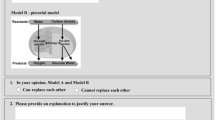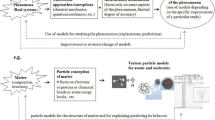Abstract
In teaching sciences, models are often used to introduce, elaborate or simplify real-world phenomena or concepts. It is, however, often the case that misconceptions arise from or are facilitated by these teaching models during their transition to mental models of the individual learners. For instance, models are often seen as direct replicas of something real—scaled versions of reality. Even though for architectural models, this approach is sufficient, in physics, other model types must also be taken into account. In particular, in quantum physics, the ability for abstract model building is essential. In our exploratory study with 3108 participants, the dispositions towards models in physics in general and models of the atomic hull in particular were analysed. Based on this quantitative data, two independent dimensions of the participants’ mental models were extracted: (i) Functional Fidelity and (ii) Fidelity of Gestalt. Based on these empirical findings, four main types of mental models are proposed.




Similar content being viewed by others
References
Dangur, V., Avargil, S., Peskin, U., & Dori, Y. J. (2014). Learning quantum chemistry via a visual-conceptual approach: students’ bidirectional textual and visual understanding. Chemistry Education Research and Practice, 15, 297–310.
Dutke, S. (1994). Mentale Modelle beim Erinnern sprachlich beschriebener räumlicher Anordnungen: Zeitliche Aspekte der Modellkonstruktion und -nutzung. Zeitschrift für Experimentelle und Angewandte Psychologie, 41, 523–548.
Fischler, H., & Lichtfeldt, M. (1992). Modern physics and students; conceptions. International Journal of Science Education, 14(2), 181–190.
Griffiths, A.K. & Preston, K.R. (1992). Grade-12 students’ misconceptions relating to fundamental characteristics of atoms and molecules. Journal of Research in Science Teaching, 29(6), 611–628.
Grosslight, L., Unger, C., Jay, E., & Smith, C. L. (1991). Understanding models and their use in science: conceptions of middle and high school students and experts. Journal of Research in Science Teaching, 28, 799–822.
Harrison, A. G., & Treagust, D. F. (1996). Secondary students’ mental models of atoms and molecules: implications for teaching chemistry. Science Education, 80(5), 509–534.
Harrison, A. G., & Treagust, D. F. (2000). Learning about atoms, molecules, and chemical bonds: a case study of multiple model use in grade 11 chemistry. Science Education, 84(3), 352–381.
Hemphill, J.F. (2003). Interpreting the magnitudes of correlation coefficients. American Psychologist, 58(1), 78–79.
Ingham, A. I., & Gilbert, J. K. (1991). The use of analogue models by students of chemistry at higher education level. International Journal of Science Education, 13(2), 203–215.
Kalkanis, G., Hadzidaki, P., & Stavrou, D. (2003). An instructional model for a radical conceptual change towards quantum mechanics concepts. Science Education, 87, 257–280.
Ke, J.-L., Monk, M., & Duschl, R. (2005). Learning Introductary Quantum Physics: sensory-motor experiences and mental models. International Journal of Science Education, 27(13), 1571–1594.
Krijtenburg-Lewerissa, K., Pol, H. J., Brinkman, A., & Joolingen, W. R. (2017). Insights into teaching quantum mechanics in secondary and lower undergraduate education. Physical Review Physics Education Research, 13, 010109.
Lichtfeldt, M. (1992). Schülervorstellungen in der Quantenphysik und ihre möglichen Veränderungen durch Unterricht. Essen: Westarp (Dissertation Freie Universität Berlin).
McDole, A. (2012). Wenn Bäche hören und Regentropfen fühlen: kindlicher Animismus -Erlebenswirklichkeit oder psychologisches Konstrukt? Marburg: Tectum.
McKagan, S. B., Perkins, K. K., & Wieman, C. E. (2008). Why we should teach the Bohr model and how to teach it effectively. Physical Review Physics Education Research, 4, 010103.
Müller, R. (2003). Quantenphysik in der Schule. Berlin: Logos.
Müller, R., & Wiesner, H. (2002). Teaching quantum mechanics on an introductory level. American Journal of Physics, 70, 200–209.
Nakiboglu, C. (2003). Instructional misconceptions of Turkish prospective chemistry teachers about orbitals and hybridization. Chemistry Education Research and Practice, 4(2), 171–188.
Nicoll, G. (2001). A report of undergraduate’s bonding misconceptions. International Journal of Science Education, 23(7), 707–730.
Papageorgiou, G., Markos, M., & Nikolaos, Z. (2016). Students’ representations of the atomic structure – the effect of some individual differences in particular task contexts. Chemistry Education Research and Practice, 17, 209–219.
Park, E. J., & Light, G. (2009). Identifying atomic structure as a threshold concept: student mental models and troublesomeness. International Journal of Science Education, 31(2), 233–258.
Petri, J., & Niedderer, H. (1998). A learning pathway in high school level quantum atomic physics. International Journal of Science Education, 20, 1075–1088.
Rickheit, G., & Sichelschmidt, L. (1999). Mental models: some questions, some answers, some suggestions. In G. Rickheit & C. Habel (Eds.), Mental models in discourse processing and reasoning (pp. 3–49). Amsterdam: North-Holland.
Schecker, H., Wilhelm, T., Hopf, M., & Duit, R. (2018). Schülervorstellungen und Physikunterricht - Ein Lehrbuch für Studium, Referendariat und Unterrichtspraxis. Wiesbaden: Springer Spektrum.
SPSS 25. (2017). IBM SPSS Statistics for Windows, Version 25.0. IBM Corp. Armonk: IBM Corp.
Stevens, S. Y., Delgato, C., & Krajcik, J. S. (2010). Developing a hypothetical multi-dimensional learning progression for the nature of matter. Journal of Research in Science Teaching, 47(6), 687–715.
Taber, K. S. (2002a). Conceptualizing quanta—illuminating the ground state of student understanding of atomic orbitals. International Journal of Science Education, 3(2), 145–158.
Taber, K. S. (2002b). Compounding quanta: probing the frontiers of student understanding of molecular orbitals. International Journal of Science Education, 3(2), 159–173.
Taber, K. S. (2005). Learning Quanta: barriers to stimulating transitions in student understanding of orbital ideas. Science Education, 89, 94–116.
Treagust, D., Chittleborough, G., & Mamiala, T. (2002). Students’ understanding of the role of scientific models in learning science. International Journal of Science Education, 24, 357–368.
Tsaparlis, G., & Papaphotis, G. (2009). High-school students‘ conceptual difficulties and attempts at conceptual change: the case of basic quantum chemical concepts. International Journal of Science Education, 31, 895–930.
Zarkadis, N., Papageorgiou, G., & Stamovlasis, D. (2017). Studying the consistency between and within the student mental models for atomic structure. Chemistry Education Research and Practice, 18, 893–902.
Acknowledgements
We are grateful for support for the realization of the online-survey to the Hans Riegel Stiftung, SciViews, Thilo Körkel of Spektrum der Wissenschaft and Breaking Lab.
Author information
Authors and Affiliations
Corresponding author
Additional information
Publisher’s Note
Springer Nature remains neutral with regard to jurisdictional claims in published maps and institutional affiliations.
Rights and permissions
About this article
Cite this article
Ubben, M.S., Heusler, S. Gestalt and Functionality as Independent Dimensions of Mental Models in Science. Res Sci Educ 51, 1349–1363 (2021). https://doi.org/10.1007/s11165-019-09892-y
Published:
Issue Date:
DOI: https://doi.org/10.1007/s11165-019-09892-y




